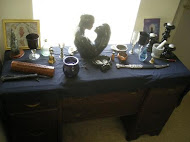Ok, so it isn't technically an herb, but it is still strongly associated with Fall in General & Samhain in particualr...
ACORN/OAK
* Celtic name: Duir (pronounced: dur). Duir means 'door' - 'D'
* Folk or Common names: Oak, The King of the Grove, Quercus, Forest King
* Latin name: White Oak - quercus alba; Red Oak - quercus rubra; Black Oak - quercus velutina; etc.
* Parts Used: acorn, leaf, bark, wood.
Herbal usage: Oaks are known for astringent tonics and therefore tea made from Oak is a good remedy for hemorrhoids . White Oak bark tea helps in sinus infections since it helps unclog congestion. Acorns can be peeled and used to make various homeopathic potions used to treat alcoholism, bad breath and constipation.
* Associations & Magical history: The Oak is associated with the element of fire and is ruled by the sun. The bird associated with this is the wren, the color is black, and the gemstone is white carnelian or moonstone. Oak's day is Thursday and it is a masculine plant. The Oak tree is associated with the Fey. In Germany, Oak trees are the fairies' favorite dwelling place, and they are especially fond of dancing around the base of the trees. The Oakmen are male dwarf faeries with huge heads who are the guardians of sacred Oak groves. They are not very friendly towards people, but no one has ever been harmed by one. Pillywiggins are small winged creatures who resemble Pixies, and that live among wildflowers which grow at the foot of huge Oaks. Another strong association of the Oak is to the Druids. The Druids were said to have worshipped in Oak-groves in Gaul and Galatia and were also said to have eaten acorns as part of their ritual preparation for foretelling the future. Oak wood is one of the nine traditional firewoods that are part of the Belfire that the Druid's burned at Beltane - it was added to the fire symbolizing the God or male principle. The Oak tree is sacred to Bridghid, Zeus, Jupiter (his voice is be heard in the rustling of Oak leaves), Hercules, The Dagda (Chief of the Elder Irish gods), Thor and all other Thunder Gods. The Oak is also associated with the Slavic spirit Perun (called that in Russian; called Piórun in Polish, Perkunas in Lithuanian, and Perkons in Latvian) who is the Spirit of thunder and of the Oak. Another deity associated with the Oak tree is the Oak King - He is the king of the waxing year and the other half of the Holly King, the king of the waning year. England honored its famous "Herne's Oak." This Oak stood for Diana and her successive lovers, the Kings of the Wood, in Greco-Roman tradition and well into the Christian era. Irish churches used to be called dair-thech, "oak-house," an old Druidic name for the sacred grove. In the eighth century, the Xtian apostle Boniface ordered the sacred Oak Groves destroyed to prove to the local Pagans that their god was worthless since he couldn't protect his tree. After this the Oak became the tree of devils to the Xtians and many condemned Witches were burnt at the stake in fires of oak wood.
Roman awarded oak leaves to military heroes. At Loch Maree in Scotland, nails and coins were driven into the trunk of an oak tree with pieces of pilgrims' clothing, as offerings. The oak was the most sacred tree of the Aryan peoples of Europe, the provider of food, housing and fire. The Oak Cult spread across Europe, from the Caucasus to the Atlantic, encompassing Celts, Slavs and Teutons. Houses in the river valleys of prehistoric northern Italy were built on oak piles. Archaeologists have found piles of acorns next to the remains of these houses. Primitive Europeans believed that oak fire strengthened the sun. Fire was kindled in ancient times by rubbing oak sticks together. Sacrifices were made to sacred oaks in Europe until well into the Middle Ages. Ancient Prussians revered sacred oak trees. The chief oak in the forest at Romove had priests who tended a perpetual fire of oak wood. This tree, draped with a cloth, was considered the dwelling place of the god. The Prussians adored it and hung images from it. There was a sacred oak tree at Hesse called the Red Jove from which omens were drawn and to which sacrifices were made. Holy oaks were preserved in Germany into modern times. First fruits of the chase were hung on oaks in Saxony and Thuringian until the 13th century. Kirwaido, God's Mouth, ruled ancient Prussians in the name of the god. When he had become weak and sick he immolated himself atop a pile of straw and thorn bushes. The blaze was lit from the perpetual fire that burned before the holy oak tree. Estonians sacrificed oxen to oaks, with prayers for rain and good crops. They also annually smeared oak trees with the blood of beasts. Lithuanians offered sacrifices to oak trees for plentiful crops. Oak trees in Siberian groves were swathed in cloth and made offerings of kettles, reindeer hides, spoons and other valuable household articles. Orthodox Christians in Russia worshiped a holy oak until the 1870's. They fixed candles to its trunk and branches and prayed: "Holy oak hallelujah, pray for us. "
The Oak was one of the sacred Druidic three: 'Oak, Ash and Thorn' and is the tree known as "The King of the Grove". The Oak has applications in magic done for all positive purposes, men, fidelity, ancestry, lightning, weather, storms, longevity, power, balance, success, money, strength, love, protection, the sun, healing, endurance, dominion, sacrifice, triumph, financial success, fertility and good luck. Uses of Oak in protective magic include placing Oak Acorns in a window to ward off lightning by appeasing the gods. Acorns hanging in windows can also protect the house against creatures that go bump in the night. Carry a piece of Oak to protect yourself from evil, or carry an acorn to prevent illness. An acorn stuck in your pocket or carried in a purse can also protect you from storms, from losing your bearings and from evil intent. An oak leaf worn at your breast, touching your heart, will save you from all deceptions. Due to the Oaks' association with the Gods of lightning, oak can be used in weather magic. Old Magic books said thunder storms could be raised by burning a chameleon's head along with oak wood. Oak can also be used to acquire good luck. An acorn can be worn around the neck to bring good luck or carry three acorns about your person and you will have a charm for youthfulness, beauty and success in life. If you tie and bind the acorns with your own hair and bless them under the new moon and the full moon, every month of the year, the charm will stay charged. The Oak is tied to Faery magic. Legend tells us that "Faery folks are in the oaks." Oak trees and groves are believed to provide safe havens and homes for many varieties of faery. Linking with the Oak Faeries can awaken visions of your future. However, if you run into faeries intent upon causing you mischief, you can neutralize their magic by turning your coat or cloak inside-out:
"Turn your clokes
For fairy folks
Are in old oakes."
And make sure you never eat any food that is offered to you by an Oakman - since it is sure to be poisonous. Oak can be used in magic for love and love divination. Carry acorns to ensure fertility. If you wish to know whether you and your present beloved will marry, take two acorns, naming them under a full moon for yourself and your lover, and drop them into a crystal bowl of well water. If they stay close to one another, as though knit by a bond, you will be sure to marry, but if they float away from one another, that is a sign that the bond will end. Oaks can also be used in general divinations - it is said that at the summer solstice the future can be divined by listening to the wind as it blows through the branches of an Oak tree. Witches often use the wood of the Oak for Witchy tools. Oak branches can be made into wands or staves. When gathering Oak, be sure to pour wine on the roots of the tree to thank it for allowing you to take a part of it. Acorns should be gathered in the daylight, and leaves and wood by night. A waning moon is the correct time to harvest Oak.
Much Information from :
Disclaimer: No one involved in this blog or its contents may be held responsible for any adverse reactions arising from following any of the instructions/recipes on this list. It is the reader's personal responsibility to exercise all precautions and use his or her own discretion if following any instructions or advice from this blog.















No comments:
Post a Comment